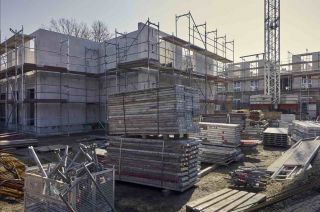
www.buildingsandcities.org/insights/commentaries/urban-scale-digital-twins-climate-adaptation.html
Can Urban Scale Digital Twins Address Climate Adaptation?

Martin Mayfield (University of Sheffield) explains the importance of Urban Scale Digital Twins for providing a holistic approach to urban and infrastructure design, operation and future proofing.
Our buildings and cities provide an important physical foundation in Maslow's hierarchy of needs. These urban infrastructure systems are essential supporting instruments of society. Mesopotamian cities provided the foundation of modern society over 9000 years ago and many of our roads and cities began their evolution over a thousand years ago. Our buildings and cities are intergenerational. They evolve gradually and some 19th century infrastructure remains viable and essential today. It is in this context that we explore the architecture and use of urban scale digital twins (USDT).
Why do this?
To ensure that any investment is robust, it is essential that the needs for USDT should not be driven by the technology itself. This is in large part why the smart city paradigm has faltered. Instead, the need for any technology should be driven by the principle that it can enable people to create happier, more productive cities in the context of emerging challenges. A key question is how these issues will affect the success of future USDT.
Research undertaken in the UK EPSRC ENCORE project (EP/N010019/1) identified that the modelling and simulation of cities faced four discrete challenges:
- cities evolve over time and this evolution is not evenly distributed across space and systems
- they are increasing in complexity
- their performance and resilience are hard to quantify and hence improve
- tension exists between performance and resilience which makes it difficult to define mutually beneficial goals.
The impacts of the climate emergency and the increasing likelihood of the extreme scenarios can be split into two categories. The direct impacts are sea level rise, frequency and intensity of severe weather events and increases in average and peak temperatures. A second category, driven by the uncertainty in our understanding of earth systems, is how feedback loops across natural and man-made systems could further increase the impact of carbon emissions.
For our cities to thrive in this context, we need a much better understanding of how they function now, how they will function under varying scenarios of climate change and what changes are required to address the challenges presented by these scenarios.
What is it for?
It is clear that under conditions of extreme climate change and increasing levels of urbanisation, the compromise of cities is a significant and growing risk. Engineers and other built environment professionals have moral and ethical obligations to society to support the public good by managing risk, reducing uncertainty and providing a long-term perspective. This must never be overridden by the objectives of individuals or organisations. It is therefore the clear responsibility of civil engineers, planners, other built environment professionals and stakeholders to ensure cities are resilient to future extreme climate change scenarios. If we are to plan for resilience, then it becomes necessary to model and understand the complex interactions of many different systems, particularly under new and challenging circumstances.
Historic and contemporary engineering takes a deterministic approach to the issue. But there are a range of climate change scenarios and a significant degree of uncertainty as to what the world will be like at the end of this century. The consequences of these scenarios vary widely.
This deterministic approach, based on traditional physics was necessary because of the significant degree of uncertainty in both the scenarios and their impact upon the cities that civilisation relies upon. However, these uncertainties are shifting much more rapidly than the prevailing regulations, standards, guidelines and best practice that shape how we design, develop and maintain our critical infrastructures and cities.
There is a need to radically change the approach to planning and design in order to ensure society is not compromised by extreme climate change. However, two current approaches are flawed and therefore must be avoided:
- processes that divide the issues between planning and design of cities, and of infrastructure. These run the risk of creating counterproductive or suboptimal solutions. Instead, these need to be considered as one system
- processes that overtly focus upon individual silos of operational carbon reduction. These need to be considered in whole life terms and across systems of buildings, mobility and logistics.
It is time to change this approach. We need tools that work across relevant scales in order to ensure decisions made on planning, design and implementation move effectively in the direction of the resilience of cities to extreme climate change. I argue that the development of urban scale digital twins is a vital tool as we strive to address climate change.
The USDT should support the further exploration of uncertainty. Many infrastructure projects are not built as designed and many are not operated as intended. The implication of this may be as simple as which electrical panel a pump is fed from, more subtle variations include how demand is managed at peak times or areas of deep uncertainty such as how these systems will perform under multiple overlapping shocks and stresses. The impact of these potential uncertainties in structure and dynamics can be better explored when the system under investigation is embedded within a wider spatially and logically defined set of systems.
How would it be done?
The potential benefits of USDTs will be realised if they are configured in a manner that responds to the unique characteristics of cities and if they leverage the plethora of tools already available. Such tools optimise at different scales and explore different issues that can be used to model and simulate urban systems and scenarios. This is inherent in the current approach used by the Centre for Digital Built Britain to encourage the development of an ecosystem of digital twins rather than attempt to create a single solution. The USDT platform should be one of many focused upon addressing particular issues at defined scales. An ecosystem approach creates an ontology within which a growing proportion of the city is represented by building information models (BIM) rather than other legacy data sets.
A USDT might include four primary components:
- data acquisition across systems
- data management
- data interfaces to commercial and research simulation tools
- data visualisation.
The objective is not to supplant current modelling and simulation tools but to provide a platform for multi-physics simulation utilising historic and real-time feedback to support planning, design and operational decision making.
There are many
potential ways that a digital twin could be used to understand, assess and address
particular issues in the built environment.
Data and models might
be considered as horizontals e.g. infrastructure systems, buildings and
environmental qualities. These tools would shed light on conventional issues of
optimisation and infrastructural performance.
All urban challenges are inherently systemic and might be considered as verticals such as mobility, productivity, health/wellbeing, energy/carbon, resource stocks/flows, and system of systems issues such as resilience which cannot be addressed by considering a single system.
When developing an
USDT, security will be an inevitable and constant challenge. The more such a
platform becomes useful to cities, the more attractive it will become as a
target and the greater the consequences of successful attacks upon it.
Cyber-security is an eternal arms race. For this reason, I would propose that
all critical infrastructure systems are 'air gapped' (i.e. isolated from other
networks) within the USDT or at the very least the feedback loops are 'air
gapped'. The potential for runaway feedback loops in systems of unknown
provenance, constitution and connectivity is also as a reason for caution.
What seems clear is that an USDT cannot be structured in the same manner as a digital twin for a jet engine. There are two key reasons for this:
- The system is open with many types of boundary definitions which vary as a function of degrees of uncertainty in the environment, available data and the nature of the query that the digital twin is being asked to address.
- A single digital twin, even one that handled only the primary infrastructural systems and agents would be unfeasibly complex and large to be handled by a single platform. The content of such a digital twin would be subject to such a large degree of change and uncertainty, outputs could not be claimed as robust or even useful.
The interdependencies outwith the system under consideration (in this case a city) are a significant source of uncertainty. Not having these connections across scales represented raises two sources of concern, one internally driven, the other external. Internally, if the local power, transport or digital networks directly connect two geographically separate parts of the city these nodes become indirectly (and perhaps directly) linked. Externally, wider systemic dynamics will have a significant impact upon the dynamics of the city scale digital twin (and vice versa). The results produced by a USDT that does not consider this will should be treated with caution.
Conclusions
The development USDTs will take years if not decades due to a number of fundamental challenges, including the ability:
- to work across scales with sufficient accuracy
- to create sufficiently accurate low order models of a high order reality in order to be useful for dynamic management of complex urban systems
- to capture, validate and verify constant change in cities.
These challenges are not unique to this domain and could be suggested as the holy trinity of modelling and simulation in open systems.
The advantage of USDT is its ability to model many different scenarios and responses - even for events that we cannot now anticipate. There are significant opportunities to improve the livelihoods of citizens and the performance of cities in the context of increasing uncertainty. We should push forward in the development of USDTs but do this in a manner that balances risks and uncertainty with benefits. This means setting off and taking risks but in a manner where the consequences can be managed and benefits and issues rapidly communicated across the communities working in this area. If we can do this in an equitable and fair manner, USDTs might become a fundamental underpinning resource for society.
Latest Peer-Reviewed Journal Content
A living lab approach to co-designing climate adaptation strategies
M K Barati & S Bankaru-Swamy
Mediation roles and ecologies within resilience-focused urban living labs
N Antaki, D Petrescu, M Schalk, E Brandao, D Calciu & V Marin
Negotiating expertise in Nepal’s post-earthquake disaster reconstruction
K Rankin, M Suji, B Pandey, J Baniya, D V Hirslund, B Limbu, N Rawal & S Shneiderman
Designing for pro-environmental behaviour change: the aspiration–reality gap
J Simpson & J Uttley
Lifetimes of demolished buildings in US and European cities
J Berglund-Brown, I Dobie, J Hewitt, C De Wolf & J Ochsendorf
Expanding the framework of urban living labs using grassroots methods
T Ahmed, I Delsante & L Migliavacca
Youth engagement in urban living labs: tools, methods and pedagogies
N Charalambous, C Panayi, C Mady, T Augustinčić & D Berc
Co-creating urban transformation: a stakeholder analysis for Germany’s heat transition
P Heger, C Bieber, M Hendawy & A Shooshtari
Placemaking living lab: creating resilient social and spatial infrastructures
M Dodd, N Madabhushi & R Lees
Church pipe organs: historical tuning records as indoor environmental evidence
B Bingley, A Knight & Y Xing
A framework for 1.5°C-aligned GHG budgets in architecture
G Betti, I Spaar, D Bachmann, A Jerosch-Herold, E Kühner, R Yang, K Avhad & S Sinning
Net zero retrofit of the building stock [editorial]
D Godoy-Shimizu & P Steadman
Co-learning in living labs: nurturing civic agency and resilience
A Belfield
The importance of multi-roles and code-switching in living labs
H Noller & A Tarik
Researchers’ shifting roles in living labs for knowledge co-production
C-C Dobre & G Faldi
Increasing civic resilience in urban living labs: city authorities’ roles
E Alatalo, M Laine & M Kyrönviita
Co-curation as civic practice in community engagement
Z Li, M Sunikka-Blank, R Purohit & F Samuel
Preserving buildings: emission reductions from circular economy strategies in Austria
N Alaux, V Kulmer, J Vogel & A Passer
Urban living labs: relationality between institutions and local circularity
P Palo, M Adelfio, J Lundin & E Brandão
Living labs: epistemic modelling, temporariness and land value
J Clossick, T Khonsari & U Steven
Co-creating interventions to prevent mosquito-borne disease transmission in hospitals
O Sloan Wood, E Lupenza, D M Agnello, J B Knudsen, M Msellem, K L Schiøler & F Saleh
Circularity at the neighbourhood scale: co-creative living lab lessons
J Honsa, A Versele, T Van de Kerckhove & C Piccardo
Positive energy districts and energy communities: how living labs create value
E Malakhatka, O Shafqat, A Sandoff & L Thuvander
Built environment governance and professionalism: the end of laissez-faire (again)
S Foxell
Co-creating justice in housing energy transitions through energy living labs
D Ricci, C Leiwakabessy, S van Wieringen, P de Koning & T Konstantinou
HVAC characterisation of existing Canadian buildings for decarbonisation retrofit identification
J Adebisi & J J McArthur
Simulation and the building performance gap [editorial]
M Donn
Developing criteria for effective building-sector commitments in nationally determined contributions
P Graham, K McFarlane & M Taheri
Join Our Community

The most important part of any journal is our people – readers, authors, reviewers, editorial board members and editors. You are cordially invited to join our community by joining our mailing list. We send out occasional emails about the journal – calls for papers, special issues, events and more.
We will not share your email with third parties. Read more



Latest Commentaries
COP30 Report
Matti Kuittinen (Aalto University) reflects on his experience of attending the 2025 UN Conference of the Parties in Belém, Brazil. The roadmaps and commitments failed to deliver the objectives of the 2025 Paris Agreement. However, 2 countries - Japan and Senegal - announced they are creating roadmaps to decarbonise their buildings. An international group of government ministers put housing on the agenda - specifying the need for reduced carbon and energy use along with affordability, quality and climate resilience.
Building-Related Research: New Context, New Challenges
Raymond J. Cole (University of British Columbia) reflects on the key challenges raised in the 34 commissioned essays for Buildings & Cities 5th anniversary. Not only are key research issues identified, but the consequences of changing contexts for conducting research and tailoring its influence on society are highlighted as key areas of action.